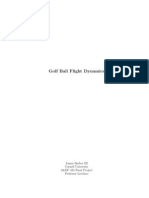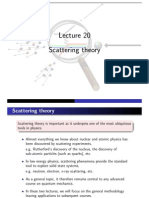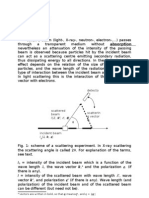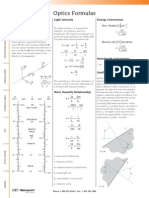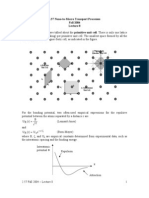Material Characterization Techniques
Material Characterization Techniques
Uploaded by
Amal ShajiCopyright:
Available Formats
Material Characterization Techniques
Material Characterization Techniques
Uploaded by
Amal ShajiOriginal Description:
Copyright
Available Formats
Share this document
Did you find this document useful?
Is this content inappropriate?
Copyright:
Available Formats
Material Characterization Techniques
Material Characterization Techniques
Uploaded by
Amal ShajiCopyright:
Available Formats
Diffraction Basics II:
Intensities
EPS400-002
Introduction to X-ray Powder Diffraction
Jim Connolly, Spring 2012
Intensity variations in Diffraction Data
Locations of diffraction peaks are related to
d-spacings of families of lattice planes
Relative intensities of diffraction peaks can
yield information about the arrangement of
atoms in the crystal structure
Intensities may be measured as
Peak heights
Areas under peaks (minus background)
By convention, the strongest peak (in a
pattern or of a particular phase in a pattern) is
assigned an intensity of 100, and all others
are reported in proportion to it.
Intensity = the vector sum of all scattering
A peak is the result of lots of scattering
Electron Scattering intensity (Thompson Eq.):
2
) 2 ( cos 1
2
2
2
2
2
u +
(
=
c m
e
r
I
I
e
O
Shows inverse square relationship to intensity
Is classical electron radius term
Is the polarization factor indicating that the Incident
beam is polarized by the scattering process
(I
o
= intensity of incident beam; r = distance from electron to detector; 2u is
angle between scattering direction and incident beam)
Atomic Scattering
Scattering from an atom
will be the sum of all
electron scattering,
defining the atomic
scattering factor, f
o
Scattering at 0 will be
the sum of electron
scattering from all
electrons
At higher scattering
angles, quantum
approximations are very
complex
f
o
is calculated for all atoms in the International Tables for
Crystallography Vol C.
A Graph of Atomic Scattering Factors
Plot of f
o
for several
elements at right
Plot shows atomic
scattering factor vs.
Sinu/
Denser atoms scatter
with greater intensity
(with some variation
related to oxidation
state)
Plots show how
intensity decreases
as the scattering
angle increases
Anomalous Scattering and Fluorescence
When the incident x-ray energy is sufficient to cause photoelectric x-
ray production in a target atom, that atom is said to fluoresce.
The photoelectric x-rays produce scattered x-rays slightly out of
phase with other scattered x-rays resulting in a reduced intensity.
Result is the absorption edge phenomenon in which peak intensity
is attenuated with certain x-radiation for particular elements.
Target (Anode)
Element
of K
o1
in
Angstroms
Elements with strong
fluoresence
Cr 2.2909 Ti, Sc, Ca
Fe 1.9373 Cr, V, Ti
Co 1.7902 Mn, Cr, V
Cu 1.5418 Co, Fe, Mn
Mo 0.7107 Y, Sr, Rb
Thermal Factor
(
=
2
2
0
sin
exp
u B
f f
2 2
8 U B t =
Where B, the Debye-Waller
temperature factor is:
Qualitatively, as
T increases, B
increases and
scattering
intensity
decreases
Shown for Cu at
right
Calculations are
very complex
and standard
values not well
agreed upon
U
2
is directly related to thermal energy, kT
Structure Factor
The structure factor is a means of grouping the atoms
in the unit cell into planar elements, developing the
diffraction intensities from each of those elements
and integrating the results into the total diffraction
intensity from each d
hkl
plane in the structure.
It describes total scattering intensity
) , ( ) (
N N
N
f hkl F | E =
Where F(hkl) is the structure factor for the hkl reflection of the unit cell,
f is the atomic scattering factor for each of N atomic planes and
| is the repeat distance between atomic planes measured from a common
origin (called the phase factor)
It is most easily visualized as an addition of vectors
(next slide)
In simplified 2D,
scattering of d
hkl
is the vector
sum of
scattering from
atomic planes
containing
atoms P, R & Q
Note how the
vector sum is
always less than
the sum of the
scalar values
The actual 3D
calculations are
extremely
complex
Extinction
In certain lattice types, the arrangement and spacing of lattice planes
produces diffractions from certain classes of planes in the structure that are
always exactly 180 out of phase producing a phenomenon called
extinction.
For a body-centered cubic cell, for each atom located at x, y, z there will be
an identical atom located at x+, y+ , z+. The structure factor F
hkl
is
represented by the following equation.
| |
|
|
.
|
\
|
(
+ + + + + +
|
|
.
|
\
|
+ + =
E
= =
2 2 2
( 2 exp ( 2 exp
2 /
1
2 /
1
l
lz
k
ky
h
hx i f lz ky hx i f
j j j
m
n
n j j j n
m
j
hkl
t t F
If h + k + l is even, the second term will contain an integer. An integral
number of 2ts will have no effect on the value of this term and F
hkl
is:
| |
j j j n
m
j
hkl
lz ky hx i f + + =
E
=
( 2 exp 2
2 /
1
t F
If h + k + l is odd, the second term will contain an term including 2t (n/2)
and the scattering vector will be 180 out of phase, and F
hkl
= 0.
Systematic Extinction
Systematic extinction is
as a consequence of
lattice type
At right is table of
systematic extinctions
for translational (i.e.,
non-rotational) symmetry
elements
Other extinctions can
occur as a consequence
of screw axis and glide
plane translations
Accidental Extinctions
may occur resulting from
mutual interference of
other scattering vectors
Symmetry Extinction Conditions
P none
C hkl; h + k = odd
B hkl; h + l = odd
A hkl; k + l = odd
I hkl; h + k + l = odd
F hkl; h, k, l mixed even and odd
2
1
b 0k0: k = odd
C b h0l: l = odd
Key: P = primitive lattice; C, B, A = side-centered on c-, b-, a-face; I = body centered; F = face centered (001)
Factors affecting intensities of Bragg
Reflections: Calculation of the Diffraction
Pattern
Consideration of all factors contributing to
relative intensities of Bragg Reflections allows
calculation of theoretical diffraction pattern for
phases whose structures are well characterized
Calculated patterns in the ICDD Powder
Diffraction File are created from this information
A qualitative understanding of these factors is
very useful in interpreting your experimental
results
The Plane Multiplicity Factor
The number of identically spaced planes cutting a
unit cell in a particular hkl family is called the plane
multiplicity factor.
For high symmetry systems, the factor can be very high
For low symmetry systems, it is low
As an example, each cubic crystal face has a diagonal (110)
and an equivalent plane. With six faces, there are 12
crystallographic orientations. The (100) will similarly have 6
orientations. Thus, the (110) family will have twice the intensity
of the (100) family because of the multiplicity factor.
The Lorentz Factor
As each lattice point on the
reciprocal lattice intersects the
diffractometer circle, a diffraction
related to the plane represented
will occur.
As angles increase, the
intersection approaches a
tangent to the circle; thus at
higher angles, more time is spent
in the diffracting condition.
This increased time will be a function of the diffraction angle
and may be corrected by inserting the term I/(sin2u cosu)
into the expression for calculating diffraction intensities.
This term is called the Lorentz factor. In practice, this is
usually combined with the atomic scattering polarization term
(Thompson equation) and called the Lorentz polarization
(Lp) correction.
Extinction from Strong Reflections
A phase-shifted reflection can occur from the
underside of very strongly reflecting planes. This will
be directed towards the incident beam but 180 out of
phase with it.
The net effect is to reduce the intensity of the incident
beam, and therefore the intensity of the diffraction
from that plane.
A similar phenomenon will reduce the penetration of
the beam into strongly diffracting planes by reducing
the primary beam energy.
Corrections are very difficult to calculate or estimate.
Careful sample preparation and a uniform small
crystallite size (~ 1 m) will reduce this effect.
This effect can still reduce the experimental
intensities of the strongest reflecting peaks by up to
25%.
Other Absorption Effects
Absorption
Related to Depth of Penetration: In a diffractometer, at low
2u values a larger area of sample is irradiated with less
depth of penetration. At higher 2u values, the irradiated area
is smaller, but depth of penetration greater. In general,
these tend to be offsetting effects as related to diffracted
intensity over the angular range of the data collection.
Linear Absorption: Calculated intensities include a term for
1/
s
where
s
is the linear absorption coefficient of the
specimen.
Microabsorption
Occurs in polyphase specimens when large crystals
preferentially interact with the beam causing both anomalous
absorption and intensities not representative of the
proportions of the phases.
The effect is minimized in diffraction experiments by
decreasing the crystallite size in the specimen
s
hkl e
hkl
v K K
I
o o
o
) (
) (
=
2
2
2 3
64
|
|
.
|
\
|
=
c m
e
r
I
K
e
o
e
t
The Intensity of diffraction peak from a flat rectangular sample of
phase o in a diffractometer with a fixed receiving slit (neglecting air
absorption), may be described as:
Here K
e
is a constant for a particular experimental system:
where:
-I
0
= incident beam intensity
-r = distance from the specimen to the detector
- = wavelength of the X-radiation
-(e
2
/m
e
c
2
)
2
is the square of the classical electron radius
-
s
= linear attenuation coefficient of the specimen
-v
o
= volume fraction of phase o
in the specimen
The Intensity Equation
The Intensity Equation (cont.)
Also, K
(hkl)o
is a constant for each diffraction reflection hkl
from the crystal structure of phase o:
hkl
m
hkl
hkl
hkl
F
V
M
K
|
|
.
|
\
|
+
=
u u
u u
o
o
o
cos sin
) 2 ( cos ) 2 ( cos 1
2
2 2
2
) (
2
) (
where:
-M
hkl
multiplicity for reflection hkl of phase o
-V
o
= volume of the unit cell of phase o
-the fraction in parentheses equals the Lorentz and polarization
corrections for the diffractometer (Lp)
hkl
, including a correction for the
diffracted beam monochromator
-2u
m
= the diffraction angle of the monochromator
-F
(hkl)o
= the structure factor for reflection hkl including anomalous
scattering and temperature effects
Putting it all together we get . . .
The Intensity Equation (cont.)
s
hkl
m
hkl
hkl
e
hkl
v
F
V
M
c m
e
r
I
I
u u
u u
t
o
o
o
o
|
|
.
|
\
|
+
|
|
.
|
\
|
=
cos sin
) 2 ( cos ) 2 ( cos 1
64
2
2 2
2
) (
2
) (
2
2
2 3
0
) (
This equation may be used to calculate the diffraction
pattern for an ideal powder.
Calculations may be done relatively easily for simple
structures. A computer (with specialized software) is
required for anything else.
Most real-world variations from ideal intensities are
related to anisotropic effects in your specimen . . .
Small disordered cells
are referred to as
amorphous
Crystallites show
sufficient extent of
repeated unit cells to
display diffraction.
Random orientation of
crystallites produce the
ideal diffraction pattern
Preferred orientation of
crystallites will produce
a significant distortion
of diffraction intensities
from the ideal.
Preferred Orientation
Many materials exhibit preferred orientation as a characteristic
property of the material.
These include many types of ceramic magnets, extruded wires,
most pressed powders and many engineered films and
polymers. Study of these materials usually require use of a
special pole-figure diffractometer to measure a particular single
diffraction.
Preferred orientation of powders is the most common source of
deviation from the ideal pattern in your diffraction data
Special specimen preparation techniques may be utilized to
minimize effects in powders
Recognition of the effects may be used to successfully identify
oriented phases in a powder pattern
Pattern fitting techniques (i.e., Reitveld) may be used to
compensate in quantitative analysis
Specialized analytical methods (i.e., for clays) make use of
preferred orientation for specialized structure analysis
Crystallite Size Effects
Extremely small crystallites will produce incoherent
scattering from the edges of the crystals. For
crystallites containing large numbers of unit cells,
these edge effects are minimized, and the diffraction
pattern approaches the ideal
The incoherent scatter can result in broadening of the
resultant peak, described by the Scherrer equation:
u |
t
t
cos
K
=
Where
t is the mean crystallite dimension,
K is the shape factor (typically about 0.9),
is the wavelength, and
|t is the line broadening (equal to the B b, B being the
breadth of the observed diffraction line at its half-intensity
maximum, and b the instrumental broadening)
Crystallite Size vs. Instrument Broadening
Instrument broadening
is the baseline line
width shown by any
diffraction peak
It is a characteristic of
the instrument and not
related to the
specimen
Crystallite or particle
size broadening is
related to deviation of
crystallite size from
ideality
Broadening related to
crystallite size is
measurable at t <1m
and not significant for
larger sizes
Residual Stress and Strain
Strain in the crystal lattice will
produce a distortion of the diffraction
line
Macrostrain causes the lattice
parameters to change resulting in a
peak shift. Glycolation or heating of
clay minerals are examples of
induced macrostrains.
Tensile and compressive forces can
produce Microstrains resulting in a
broadening of the diffraction peaks or
peak asymetry in some cases.
Dislocations, vacancies, shear
planes, etc can produce Microstress.
The result can be a distribution of
peaks around the unstressed peak
location, appearing like a crude
broadening of the peak.
Mudmaster
An excellent tool for understanding particle size and
strain effects (and calculating them) in the diffraction
pattern is Mudmaster from Dennis Eberl
Reference: Mudmaster: A Program for Calculating
Crystallite Size from Distributions and Strain from the
Shapes of the Diffraction Peaks by Dennis Eberl, et
al., U.S. Geological Survey Open-File Report 96-171,
1996.
Program uses Microsoft Excel (with Solver and
Statistical add-on tools installed) to do calculations
Available by free download via FTP at:
ftp://brrcrftp.cr.usgs.gov/pub/ddeberl/MudMaster/
or
ftp://eps.unm.edu/pub/xrd/MudMast.zip
Next time:
Clay Minerals, mineralogy and X-ray
diffraction (Guest lecture by Dr. Dewey
Moore)
Review Q&A Session prior to hour exam
(Exam two weeks from today)
You might also like
- Ans HW2Document8 pagesAns HW2Sai Swetha KVNo ratings yet
- Golf Ball DynamicsDocument16 pagesGolf Ball DynamicsAmal ShajiNo ratings yet
- Rocket Equation of MotionDocument13 pagesRocket Equation of MotionAmal ShajiNo ratings yet
- 06 Diffraction Basics IIDocument28 pages06 Diffraction Basics IIAli HuertaNo ratings yet
- Lec20-21 - Compressed SCATTER PDFDocument54 pagesLec20-21 - Compressed SCATTER PDFBobby WardNo ratings yet
- Clusters of Galaxies in The Radio: Relativistic Plasma and ICM/Radio Galaxy Interaction ProcessesDocument34 pagesClusters of Galaxies in The Radio: Relativistic Plasma and ICM/Radio Galaxy Interaction ProcessespjblkNo ratings yet
- Chapter 3c X Ray DiffractionDocument40 pagesChapter 3c X Ray DiffractiondhandametNo ratings yet
- X Ray DiffractionDocument26 pagesX Ray DiffractionAkash BhardwajNo ratings yet
- Name:Sajeel Khan ROLL#:M.phil-SSP-03-F19 Class: M.phil SSP (Morning) Subject: X-Ray Diffraction Submitted TO: Dr. Shahid Atiq SBDocument13 pagesName:Sajeel Khan ROLL#:M.phil-SSP-03-F19 Class: M.phil SSP (Morning) Subject: X-Ray Diffraction Submitted TO: Dr. Shahid Atiq SBAnonymous f7wV1lQKRNo ratings yet
- Fundamental Concepts - Continued Dispersion of Light: Lecture Notes - Part IIDocument56 pagesFundamental Concepts - Continued Dispersion of Light: Lecture Notes - Part IIRouaNo ratings yet
- Lecture Note On Photon Interection An Cross SectionDocument21 pagesLecture Note On Photon Interection An Cross SectionpankajNo ratings yet
- Structure Factors & Fourier TransformsDocument32 pagesStructure Factors & Fourier TransformsAsrafulNo ratings yet
- Light ScatteringDocument10 pagesLight ScatteringAndri HanryansyahNo ratings yet
- 09 06061601 KMP TroschyoDocument14 pages09 06061601 KMP TroschyoSandip MaityNo ratings yet
- X-Ray Fluorescence: Energy-Dispersive Technique (EDXRF) : Advanced Physics Laboratory XRFDocument28 pagesX-Ray Fluorescence: Energy-Dispersive Technique (EDXRF) : Advanced Physics Laboratory XRFmantaptoNo ratings yet
- The Spectrum of A Single Photoionized CloudDocument17 pagesThe Spectrum of A Single Photoionized Cloudchewbacca1409No ratings yet
- Study of Various Designs of Solid State Laser Oscillator: Kireet Semwal, S. C. BhattDocument12 pagesStudy of Various Designs of Solid State Laser Oscillator: Kireet Semwal, S. C. BhattIOSRJEN : hard copy, certificates, Call for Papers 2013, publishing of journalNo ratings yet
- Determination of Wave Length of Laser Radiation by Interference. Jung MethodDocument12 pagesDetermination of Wave Length of Laser Radiation by Interference. Jung MethodMəhəmmədəliNo ratings yet
- The Sunyaev-Zel'dovich Effect in Cosmology and Cluster PhysicsDocument31 pagesThe Sunyaev-Zel'dovich Effect in Cosmology and Cluster PhysicspjblkNo ratings yet
- Radiation: Emission of Thermal Radiation From The Surface. Thermal Radiation FromDocument24 pagesRadiation: Emission of Thermal Radiation From The Surface. Thermal Radiation FromAjay YadavNo ratings yet
- XRD TheoryDocument7 pagesXRD TheoryAdarta MuhNo ratings yet
- RP2.1 Lesson1Document34 pagesRP2.1 Lesson1Taushiful HoqueNo ratings yet
- Chapter 5. Periodicity & Atomic Structure Wave PhenomenaDocument4 pagesChapter 5. Periodicity & Atomic Structure Wave PhenomenaVictoria MooreNo ratings yet
- TUPMN038Document3 pagesTUPMN038Particle Beam Physics LabNo ratings yet
- E3877 Optics FormulasDocument6 pagesE3877 Optics FormulasKaran DoshiNo ratings yet
- Lecture - Electron DiffractionDocument12 pagesLecture - Electron DiffractionOlivia WahyudiNo ratings yet
- Double Slit: Mathematical Model of Interference Pat Tern and Photon ScatteringDocument12 pagesDouble Slit: Mathematical Model of Interference Pat Tern and Photon ScatteringOliver58No ratings yet
- Quantum Mechanics and Laser TechnologyDocument31 pagesQuantum Mechanics and Laser TechnologyAlap PatelNo ratings yet
- Radiant Heat TransferDocument20 pagesRadiant Heat TransferAnonymous ioNuZrgNo ratings yet
- Diffraction: Figure 1 - Diffraction Through An ApertureDocument4 pagesDiffraction: Figure 1 - Diffraction Through An ApertureloulepetitloupNo ratings yet
- Rosenzweig 1998 0154Document19 pagesRosenzweig 1998 0154Particle Beam Physics LabNo ratings yet
- Lab ManualDocument16 pagesLab ManualJhonny raunNo ratings yet
- A Simplified Approach To Synchrotron RadiationDocument8 pagesA Simplified Approach To Synchrotron RadiationFaisal AmirNo ratings yet
- X-Ray Diffraction: Dr. Mukesh KumarDocument31 pagesX-Ray Diffraction: Dr. Mukesh Kumarhimanshu singhNo ratings yet
- TMP 8 DD2Document3 pagesTMP 8 DD2FrontiersNo ratings yet
- 02Document79 pages02Dan FarrisNo ratings yet
- Chapter 3c X Ray DiffractionDocument48 pagesChapter 3c X Ray DiffractionAnup Dalal100% (1)
- PolarizationDocument10 pagesPolarizationMarco San Martín HormazábalNo ratings yet
- Chapter 11 - Radiation Fundamentals 2Document20 pagesChapter 11 - Radiation Fundamentals 2Rithish MouryaNo ratings yet
- LAB 3 Radiation Heat TrasferDocument16 pagesLAB 3 Radiation Heat TrasferMastura Ahmad Termizi89% (19)
- Dissociation Energy of Iodine by Absorption SpectroscopyFINALDocument12 pagesDissociation Energy of Iodine by Absorption SpectroscopyFINALwillharvey94100% (1)
- MSP-705 Non Linear Optics - Notes 1Document95 pagesMSP-705 Non Linear Optics - Notes 1ArathyNo ratings yet
- 5-X Ray DiffractionDocument24 pages5-X Ray DiffractionYagnesh Rohit100% (1)
- Optical TweezersDocument22 pagesOptical TweezersconcebaysNo ratings yet
- Acousto Optics Modulator 1Document9 pagesAcousto Optics Modulator 1SURESH SURAGANINo ratings yet
- P and P Are The Slopes of The Travel Time Curves T-versus-X and T-Versus-, RespectivelyDocument38 pagesP and P Are The Slopes of The Travel Time Curves T-versus-X and T-Versus-, RespectivelyKiswanto Habib IhsaniNo ratings yet
- Consequences of The Kramers-Kronig Relations For Light Diffraction On Thick GratingsDocument3 pagesConsequences of The Kramers-Kronig Relations For Light Diffraction On Thick GratingsginesNo ratings yet
- 2.57 Nano-to-Macro Transport Processes Fall 2004: A Wigner-Seitz Primitive Unit CellDocument6 pages2.57 Nano-to-Macro Transport Processes Fall 2004: A Wigner-Seitz Primitive Unit CellcaptainhassNo ratings yet
- B R R - J E: Lackbody Adiation and The Ayleigh Eans QuationDocument7 pagesB R R - J E: Lackbody Adiation and The Ayleigh Eans QuationcromtarNo ratings yet
- Geophysical Research Letters - 2020 - Claudepierre - Empirically Estimated Electron Lifetimes in The Earth S RadiationDocument9 pagesGeophysical Research Letters - 2020 - Claudepierre - Empirically Estimated Electron Lifetimes in The Earth S RadiationCH YNo ratings yet
- Week 9 RadiationDocument23 pagesWeek 9 RadiationKamranNo ratings yet
- X Ray ReflectometryDocument28 pagesX Ray ReflectometrypyrgonNo ratings yet
- Structure Analysis Electron DiffractionDocument22 pagesStructure Analysis Electron Diffraction陳帥睿No ratings yet
- Coherent Soft X-Ray Scattering For Studying Nanoscale MaterialsDocument36 pagesCoherent Soft X-Ray Scattering For Studying Nanoscale MaterialsAvanindra Kumar PandeyaNo ratings yet
- nl1c04887 Si 001Document8 pagesnl1c04887 Si 00144xbr88kspNo ratings yet
- Solar Radiation: Lecture NotesDocument7 pagesSolar Radiation: Lecture NotesPHjecrisNo ratings yet
- Gamma Radiation Shielding: e I e I X IDocument4 pagesGamma Radiation Shielding: e I e I X IRengaraj RamasubbuNo ratings yet
- Radiation Heat Transfer ExperimentDocument11 pagesRadiation Heat Transfer ExperimentYunus Emre Güzelel0% (1)
- Radiation Heat Transfer Experiment PDFDocument11 pagesRadiation Heat Transfer Experiment PDFTuba JavedNo ratings yet
- Quantum Theory of Exciton-Polaritons With Spatial DispersionDocument6 pagesQuantum Theory of Exciton-Polaritons With Spatial DispersionSubhasish GuhaNo ratings yet
- Electron Beam-Specimen Interactions and Simulation Methods in MicroscopyFrom EverandElectron Beam-Specimen Interactions and Simulation Methods in MicroscopyNo ratings yet
- Application 2015 ExampleDocument8 pagesApplication 2015 ExampleAmy TrangNo ratings yet
- Energy in Emerging MarketsDocument37 pagesEnergy in Emerging MarketsAmal ShajiNo ratings yet
- Materials SelectionDocument44 pagesMaterials SelectionMAO20100No ratings yet
- Revised-GRE-Wordlist(James Jiang小姜老师整理)Document27 pagesRevised-GRE-Wordlist(James Jiang小姜老师整理)James JiangNo ratings yet
- Group ComponentDocument1 pageGroup ComponentAmal ShajiNo ratings yet
- Rocket Propulsion: General Principles of A Rocket MotorDocument9 pagesRocket Propulsion: General Principles of A Rocket MotorAmal ShajiNo ratings yet
- MM356 - MC - Lab Notes - 2024 - SM - 240116 - 191238Document42 pagesMM356 - MC - Lab Notes - 2024 - SM - 240116 - 191238yonknownNo ratings yet
- Pengolahan Data XRD.2020.04.01Document14 pagesPengolahan Data XRD.2020.04.01Zulfa SeffNo ratings yet
- Phytosynthesis of Silver Nanoparticles Using Evaluation of Antibacterial, Antioxidant, and Anticancer ActivitiesDocument15 pagesPhytosynthesis of Silver Nanoparticles Using Evaluation of Antibacterial, Antioxidant, and Anticancer ActivitiesBashar AliNo ratings yet
- 1 s2.0 S0003267023012965 MainDocument15 pages1 s2.0 S0003267023012965 MainLeonardo BoaesNo ratings yet
- Synergetic Effects of Lanthanum Substituted Ni-Zn-Cu-Co Ferrite Nanocomposite With Enhanced NH3 Sensing PerformanceDocument10 pagesSynergetic Effects of Lanthanum Substituted Ni-Zn-Cu-Co Ferrite Nanocomposite With Enhanced NH3 Sensing PerformanceChnar AzizNo ratings yet
- CuFe2O4 CopreciptationDocument8 pagesCuFe2O4 CopreciptationThủy Tiên Đặng ThịNo ratings yet
- Calicut University M.SC PHYSICS Experimental Techniques X-RAY DIFFRACTION TECHNIQUES JOYAL (STC)Document22 pagesCalicut University M.SC PHYSICS Experimental Techniques X-RAY DIFFRACTION TECHNIQUES JOYAL (STC)Joyal Jain100% (1)
- X-Ray Diffraction (XRD) : CENG 1500Document11 pagesX-Ray Diffraction (XRD) : CENG 1500杨致远No ratings yet
- XRD Analysis ThesisDocument6 pagesXRD Analysis ThesisBuyCheapPapersOnlineOmaha100% (2)
- Scherrer Equation - WikipediaDocument7 pagesScherrer Equation - WikipediaSilviu-Laurentiu BadeaNo ratings yet
- 1.3.4 Sequeira Fronia PearlDocument45 pages1.3.4 Sequeira Fronia Pearlmohd ayanNo ratings yet
- Article 12Document8 pagesArticle 12Maroc EcoloadNo ratings yet
- Synthesis, Characterization and Magnetic Properties of Cafe2O4 Nanoparticles by Solution Combustion MethodDocument9 pagesSynthesis, Characterization and Magnetic Properties of Cafe2O4 Nanoparticles by Solution Combustion MethodNuman AhmadNo ratings yet
- PHD Thesis X Ray DiffractionDocument4 pagesPHD Thesis X Ray Diffractiongerridominguezpalmdale100% (2)
- XRD 1Document47 pagesXRD 1Bakhita MaryamNo ratings yet
- 10.1007/s10854 016 6242 2Document13 pages10.1007/s10854 016 6242 2AnaGomezNo ratings yet
- Structural Analysis of PAN Fiber by X-Ray Diffraction: January 2010Document7 pagesStructural Analysis of PAN Fiber by X-Ray Diffraction: January 2010Constantin Anghelina PuiuNo ratings yet
- Scherrer EquationDocument1 pageScherrer EquationGera FJNo ratings yet
- Nano 1212Document13 pagesNano 1212azkayounas74No ratings yet
- Magnetic Behavior of Natural Magnetite (Fe3O4) Extracted From Beach Sand Obtained by Mechanical Alloying MethodDocument5 pagesMagnetic Behavior of Natural Magnetite (Fe3O4) Extracted From Beach Sand Obtained by Mechanical Alloying MethodSari Ramadhani MeutuahNo ratings yet
- XRD BroadeningDocument14 pagesXRD BroadeningViet NguyenHoangNo ratings yet
- Copper Plating From Non-Cyanide Alkaline BathsDocument7 pagesCopper Plating From Non-Cyanide Alkaline BathsDerdo ZulmuNo ratings yet
- Correlation Between Experimental and DFT CalculatiDocument13 pagesCorrelation Between Experimental and DFT Calculatiolfa massaoudigppNo ratings yet
- Method For Determining Crystal Grain Size by X-RayDocument6 pagesMethod For Determining Crystal Grain Size by X-RayJulio César Huillca HuillcaNo ratings yet
- Influence of Platinum On Mordenite Properties and Catalytic Activity Towards Cyclohexene EpoxidationDocument12 pagesInfluence of Platinum On Mordenite Properties and Catalytic Activity Towards Cyclohexene Epoxidationbruno barrosNo ratings yet
- Shreya Book ChapterDocument9 pagesShreya Book ChapterShreyaNo ratings yet
- Co MOF XRDDocument22 pagesCo MOF XRDviznygraceNo ratings yet
- 1 s2.0 S0925400514000859 MainDocument8 pages1 s2.0 S0925400514000859 Main1900066No ratings yet
- WSPC Nano D 23 00348Document31 pagesWSPC Nano D 23 00348tasadukNo ratings yet
- UV IR Raman XRD PDFDocument11 pagesUV IR Raman XRD PDFHareeshNo ratings yet

